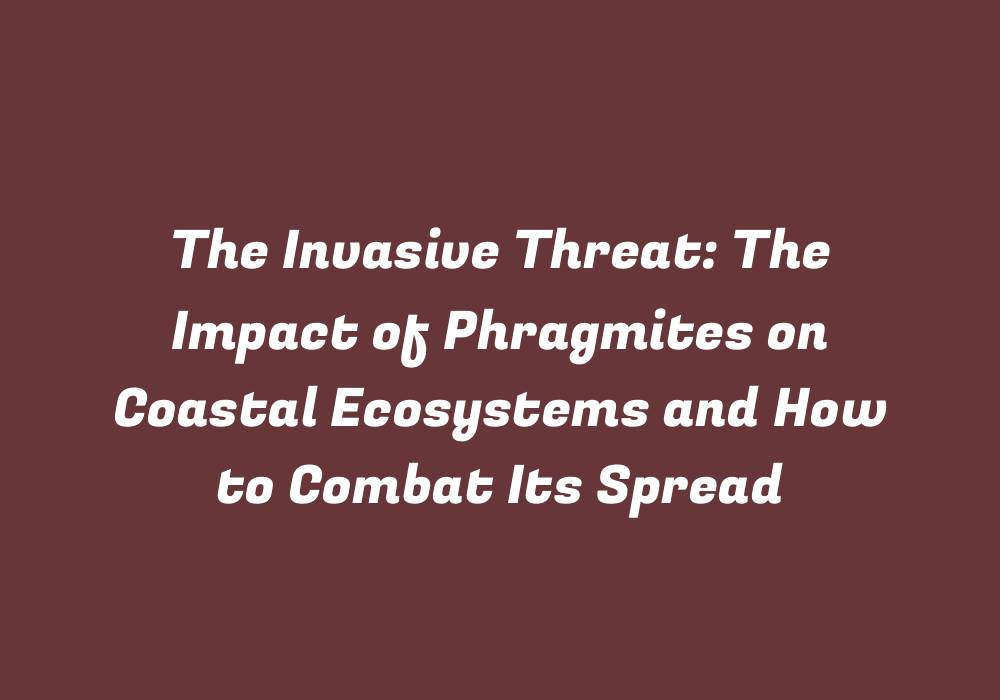The Invasive Threat: The Impact of Phragmites on Coastal Ecosystems and How to Combat Its Spread
Introduction
Phragmites australis, commonly referred to as common reed or giant reed, is a tall perennial grass native to Europe, Asia, and Africa. Due to its ability to thrive in various habitats such as wetlands, marshes, and floodplains, this plant has been accidentally introduced into numerous regions across the globe, including North America. The invasive nature of Phragmites australis has led to significant changes within coastal ecosystems, resulting in substantial impacts on both wildlife and human activities. This article delves into the key consequences of this invasive plant’s presence, as well as explores possible strategies for combating its spread.
Negative Impacts on Coastal Ecosystems
Habitat Alteration
One of the most critical aspects of Phragmites australis’s impact is the alteration of coastal ecosystems due to the aggressive growth and expansion of its root systems. This species can form dense monocultures, which outcompete native plants and reduce overall biodiversity in the area. Consequently, this may lead to a decline in wildlife populations that rely on these diverse habitats for food and shelter.
Displacement of Native Species
As Phragmites australis establishes itself within coastal ecosystems, it often displaces native plant species, ultimately diminishing their presence in the area. In many cases, this results in a significant reduction in habitat complexity, further impacting wildlife communities that depend on diverse vegetation for survival. Moreover, the loss of these native plants may also affect the food web dynamics and overall stability of coastal ecosystems.
Obstruction to Navigation and Recreation
The rapid growth of Phragmites australis often results in a dense mass of vegetation that impedes recreational activities such as boating, fishing, and swimming. In some instances, the plant’s roots can even penetrate watercraft hulls, leading to costly repairs or even accidents. Furthermore, its presence may restrict access to important coastal resources for both wildlife and human communities alike.
Reduction in Water Quality
Phragmites australis can absorb a considerable amount of nutrients from water bodies, leading to an increased risk of eutrophication (excessive growth of algae due to high nutrient levels). This phenomenon may result in reduced water quality and the proliferation of harmful algal blooms, which can be detrimental to both aquatic life and human health.
Combat Strategies for Phragmites australis
Given the numerous negative impacts caused by the invasive nature of Phragmites australis, it is crucial to develop effective strategies for its control and eradication. Some potential solutions include:
Early Detection and Rapid Response
Identifying the presence of invasive plants in their early stages of growth allows for more efficient management efforts, preventing further spread and minimizing overall impacts on coastal ecosystems. This can be achieved through regular monitoring and surveillance programs that focus on areas known to be at risk for Phragmites australis invasion.
Mechanical Control
Physically removing or cutting down large quantities of Phragmites australis may help reduce its impact on coastal ecosystems and improve water quality. However, this method can also have unintended consequences such as increased nutrient release due to decomposing plant material.
Chemical Control
The use of selective herbicides can effectively target Phragmites australis without harming other desirable plant species within the ecosystem. This method is often employed in combination with mechanical control to provide a more comprehensive approach to managing invasive plants.
Biological Control
Introducing specific insects, fungi, or pathogens that can naturally regulate Phragmites australis populations without causing harm to other plant species is another viable option for controlling the spread of this invasive plant. This approach has shown promise in some cases but requires careful monitoring and evaluation to ensure it remains effective over time.
Integrated Management Approaches
A combination of these control methods, along with ongoing research efforts aimed at enhancing our understanding of Phragmites australis’s biology and ecological impacts, can provide an integrated approach for minimizing the threats posed by this invasive species to coastal ecosystems. By implementing a multifaceted strategy that includes early detection, targeted control measures, and ongoing monitoring, we can better ensure the long-term preservation of diverse and healthy coastal habitats.
Conclusion
The spread of Phragmites australis throughout various regions has resulted in significant ecological consequences for coastal ecosystems. By identifying key impacts such as habitat alteration, species displacement, impeded navigation, reduced water quality, and the need for integrated management strategies to combat its spread, we can better understand the challenges posed by this invasive grass species. By implementing early detection and response measures alongside various control techniques, efforts are underway to minimize these impacts and preserve our coastal environments’ rich biodiversity.
